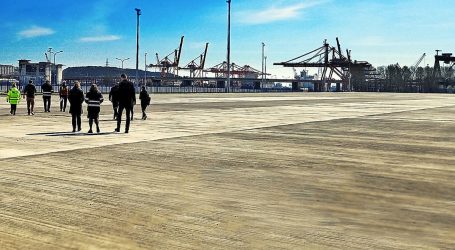Orlen looks at options to increase LPG import capacity
Orlen is analysing the possibilities of increasing LPG import capacity and greater diversification of the directions of its supply; the company told PAP. It added that a concept for developing such activities at the Port of Police is being prepared.
PAP asked Orlen at what stage is the current cooperation with Grupa Azoty regarding expanding the port in Police. In the spring of this year, Grupa Azoty reported that Orlen wanted to build more tanks at the port.
– Work is underway to prepare a programme and spatial concept to be presented in the coming months, Orlen replied.
The conglomerate pointed out that the project is still being developed.
– Orlen is analysing the possibilities of increasing LPG import capacity and greater diversification of the directions of supply of this fuel, the company added, stressing that it is too early at this stage to make final decisions on the implementation of these plans.
A report by the Polish LPG Organisation (POGP) shows that in the first half of 2023. LPG was mainly supplied to Poland by rail – 53.2 per cent, with 34.6 per cent going by sea and 8.6 per cent by road.
According to POGP, the structure of the Polish market’s LPG supply in H1 2023 was as follows:
– Production amounted to 228,000 tonnes, covering 15 per cent of demand, with imports accounting for the remainder. Russia remained the largest supplier, with its share of the import structure increasing slightly from 48.7 per cent to 50.1 per cent compared to H1 2022. – stated the industry organisation’s report.
It explained that the continued “strength of Russian supplies” is due to three elements: “logistical connections and availability of terminals on the eastern border, a competitive price (on average 1/6 lower in 2023 than from alternative directions) and the dominant role of autogas in the Polish LPG market, which means stable demand for the Russian blend”.
POGP notes that while LPG supplies from Russia showed a declining trend in the first half of 2022, they increased again from autumn to the end of the heating season, recording a peak in March 2023, when nearly 140,000 tonnes of raw material were imported into Poland.
Tomasz Hinc emphasised in May this year that Grupa Azoty has built and is already using its gas port in Police with large tanks for propane and ethylene.
– We are in advanced talks with other state-owned companies, such as KGHM on a major expansion of the port, or with PKN Orlen on the construction of further tanks at the port,” Grupa Azoty CEO Tomasz Hinc told PAP at the time.
POGP director Bartosz Kwiatkowski estimated in an interview with PAP in April this year that double-digit growth of the LPG market in Poland should be expected in 2023 due to the planned launch of production of propane-produced polypropylene by Grupa Azoty Polyolefins.
– As a result of the launch of this plant and the growing use of LPG in the industrial sector, the share of the industrial segment in the market structure will also increase in the coming years, Kwiatkowski told PAP in an interview.
On 13 November this year. Azoty Group reported, however, that the start-up of the Azoty Polyolefins Group plant may be delayed by 166 days from 31 August this year due to a letter to this effect submitted by Hyundai Engineering, the general contractor of the Polymers Police complex.
Who owns the LPG terminals in Polish ports? When did they accept LPG from Russia?
February 2022 saw Russia’s invasion of Ukraine and the start of full-scale hostilities on a broad front. Since the beginning of March 2022, there have been only 18 LPG tanker calls with cargoes delivered from Russian ports (specifically one – Ust-Luga) to Polish ports (strictly speaking, only to the LPG terminal in Gdynia).
The last two LPG deliveries occurred on 10 and 20 March 2023 (the Eco Dream vessel with a carrying capacity of approximately 5240 t).
These deliveries were made by Greek shipowner StealthGas Inc. vessels and the UAE-based Nordic Sea Scape Shipping LLC.
The last two deliveries of LPG from Russia (also from Ust-Luga) to the Gdansk terminal occurred on 21 and 29 November 2021 (vessels Alkaid and Alcor with approximately 22,770t deadweight each).
In Szczecin, the last two LPG ship calls from Russia occurred on 11 and 28 November 2021 (ship B Gas Maud, approximately 5070 t deadweight).
A small Orlen LPG terminal is in operation in Szczecin. Another one, small but slightly larger than the one in Szczecin – in Gdynia. The latter belongs to Alpetrol of the Onico SA capital group.
The largest LPG terminals, capable of receiving Poland’s largest LPG carriers, are owned by Gaspol SA in Gdansk and – more recently – by Grupa Azoty in Police. The Azoty terminal has so far only served the needs of the Azoty Group’s chemical plants.
The LPG distribution industry is calling for Gaspol’s private LPG terminal in Gdansk to become a public terminal, i.e., commercial, to serve the cargo of other dispatchers/importers.
Poland has recently been the EU’s largest importer of Russian LPG, but all trade has been through land terminals in eastern Poland. The LNG market is much larger in the EU. The EU countries leading in LNG imports from Russia (e.g. Belgium) import many times more of it than Poland imports LPG. Poland no longer imports natural gas from Russia at all. In its history, not a single shipment of LNG from Russia has been imported by sea – via the Świnoujście terminal.
Source: PortalMorski.pl




